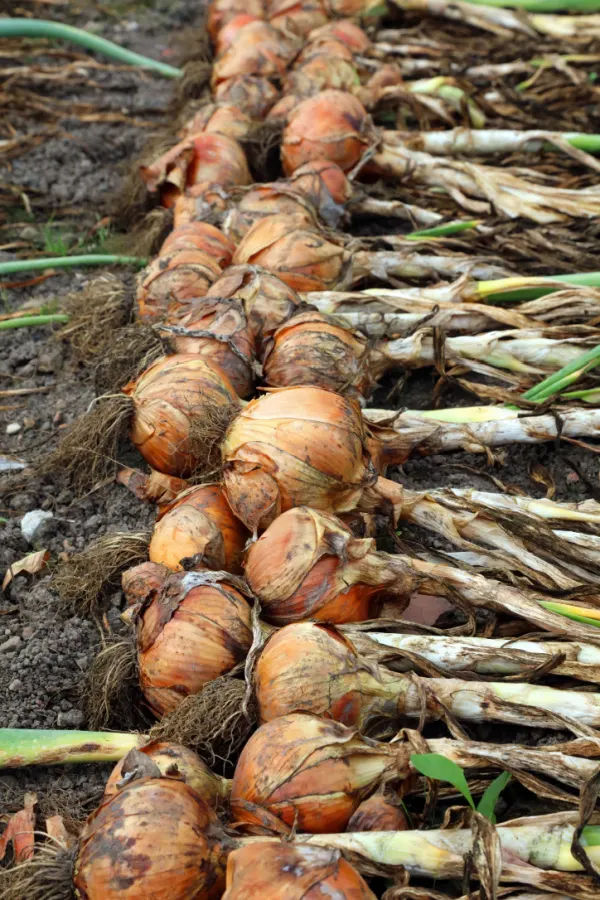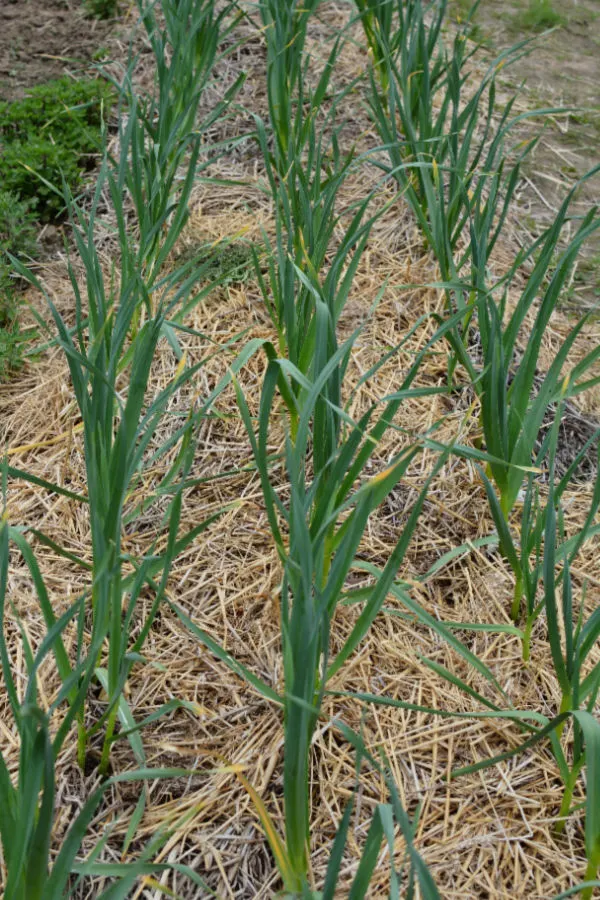There is simply no better time to plant onions than in the fall. Especially if you want to grow bigger, sweeter and more delicious onions than you ever thought possible!
Even though you can plant onions in the spring, fall planting has a few major advantages versus onions that go in the ground early in the season. One of the biggest advantages of all is that the soil is far warmer in the fall than in the early spring – which happens to be perfect for fast growth.
Unlike in March and April when the soil temperatures can still be cool from winter’s chill, the ground in early autumn is warm from the summer sun. Because of that, newly planted onion sets or seeds can germinate fast. Even better, that warm soil also helps them grow and quickly establish a strong root system before winter sets in.
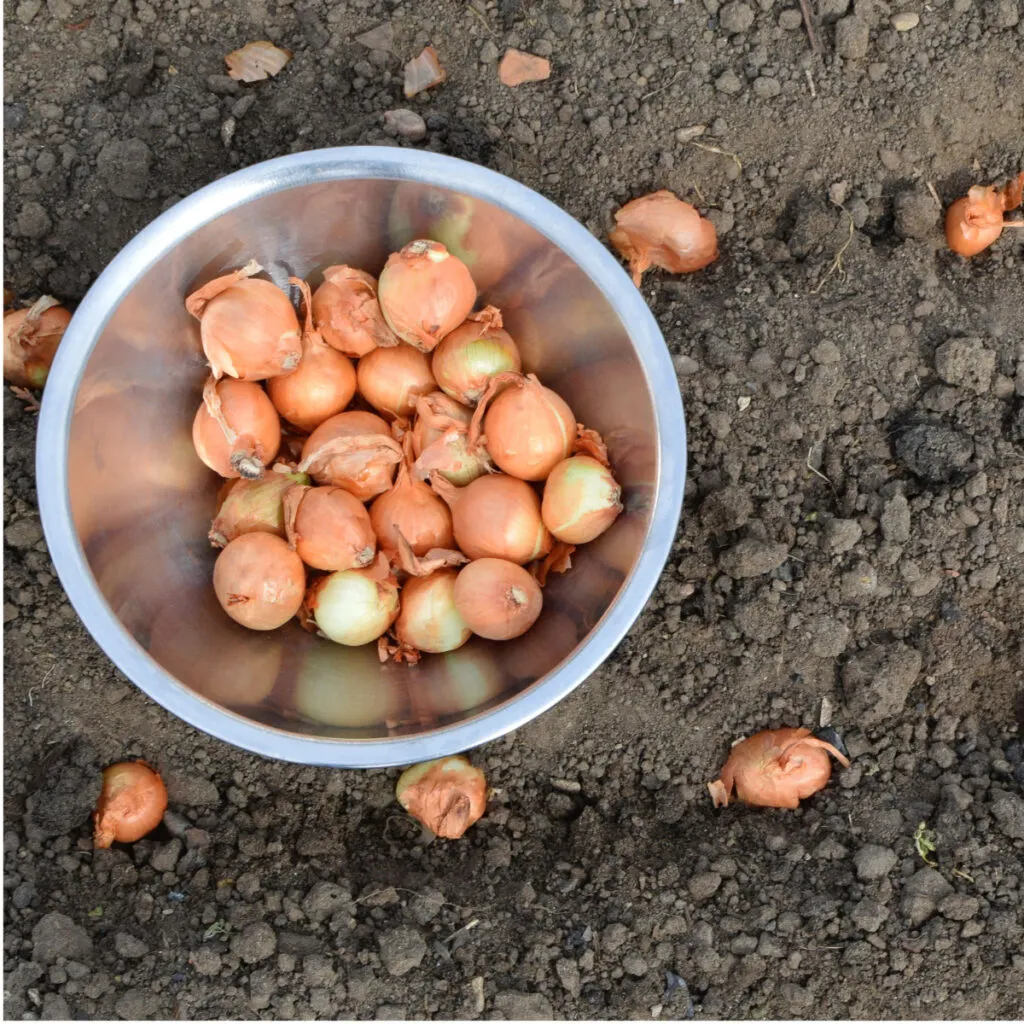
Much like fall planted garlic, onion bulbs sprout and establish in the soil fall soil and then go dormant once the chill of winter arrives. And just like garlic, as the temperatures and soil warm again in early spring, the crop comes back to life. See: 5 Big Tips To Planting Garlic & Onions In The Fall
But for both crops, it is that over-winter chilling period that really helps their bulbs develop serious flavor and size. Because the roots had time to establish before winter, the bulbs have a head start on spring growing. And it’s that head start that allows them to really fill with flavor once spring arrives!
The Difference Between Spring & Fall Onions – How To Plant Onions In The Fall
We actually plant both a fall and spring crop of onions every year in our garden. We use our spring planted onions to pull for green or early onions – meanwhile, we let our fall onions grow to full size and maturity.
Even though we love the fresh spring onion taste, without a doubt, our fall crop always seems to bring a much larger and better tasting onion than our same-year planted onions. Fall planted onions also mature earlier. In fact, some of our fall onions can usually be harvested at near full size as early as the following June.
With fall planting in mind – here is a look at how to plant your onions this autumn for big flavor next summer!
How To Plant Onions In The Fall
When To Plant Fall Onions
The key to knowing when to plant onions in the fall is knowing how much time they need in the soil to establish before the cold arrives. For fall long-day onion varieties, that means allowing 4 to 6 weeks of warmer temperatures to let them set their roots.
Here in the Ohio, we usually plant our fall onion sets during the first to middle portion of September. That gives plenty of time for growth before winter – but allows the temperatures to be warm but not overly hot for the onions starting out.
So what about planting seeds versus onion sets? For us, hands down, we prefer planting onion sets over seed. For starters, they establish quickly in the soil and are easier to plant. Seeds can be hard to plant evenly. In addition, they sprout and grow so thin that they can easily be overwhelmed by weeds.
Finally, onion sets simply grow larger bulbs. Onion sets are onion seeds that have already sprouted and grown a bit. By their very nature, they will mature faster and to a larger size. So for us, we have always decided to give our onions the jump start with sets!
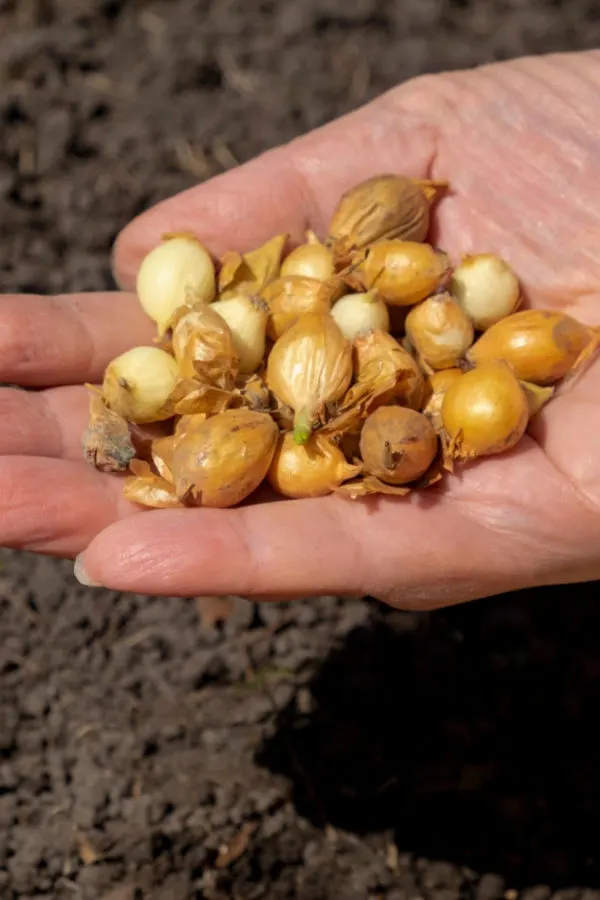
Get Your Onion Sets Early – How To Plant Onions In The Fall
The one problem with fall planting is that it can sometimes be difficult to find sets in stock locally. Check with your local greenhouse and/or garden center early to see if they will be carrying stock. If not, you can also find them on line.
One thing is for sure – get them as early as you can to have them ready to go. Onion sets will keep as long as you keep them in a cool, dark spot. We usually plant a mix of white, yellow and red onions each fall to have a good variety the following year. Affiliate Product Link : Mixed Onion Sets
If you do want to go the seed route, you will want to plant them in the ground 3 to 4 weeks earlier than onion sets. This allows them to get a bit of a head start and develop a root system before going dormant in the fall. Affiliate Product Link: Onions Seed Variety Pack
Soil Preparation – How To Plant Fall Onions
Growing great onions, whether in the spring or fall, all starts with great soil. Onions, grow best in loose, fertile and well-draining soil. To make sure of that – adding compost before planting is a BIG plus!

No matter if you plant in long rows, or with individual holes in raised beds, adding compost to the bottom of the planting hole is a must. The same goes for adding to garlic planting rows or holes in the fall as well.
We like to add about an inch of compost to the bottom of each row before planting. This gives the onion bulb loose, nutrient-filled soil to establish quickly.
Amending your soil is even more important if your soil is hard or clay-like. The harder the soil, the less likely root crops can reach their full potential. For hard soils, add in equal amounts of compost and sand prior to planting. This helps with both drainage and root growth as the bulbs sprout.
Planting Your Bulbs – How To Plant Fall Onions In The Fall
For our onion bulbs, we dig a trench in the soil two inches deep and a two to three inches wide. For this task, a mattock (often called a garden pick) is the perfect tool. It can easily be drawn through the soil, and makes a perfect three inch wide trench with ease.
We actually use our mattock for all of our trench planted crops like corn, beans and garlic. It is an amazing hand tool to own for sure around the garden and home! Product Affiliate Link : 36″ Heavy Duty Mattock
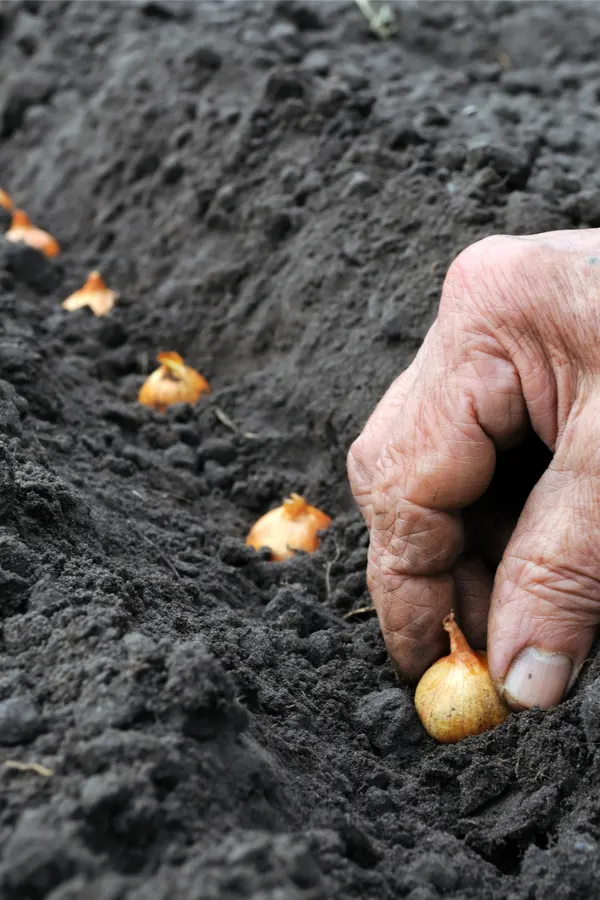
Before planting, we fill the trench in with about an inch to an inch and a half of compost. Next, we plant the bulbs into the trench, setting them down in the compost a bit. Always plant your bulbs with the pointy end facing up. This helps the bulbs sprout quickly through the soil.
We like to space our bulbs 4 to 6 inches apart. This spacing allows plenty of room for growth. This is important for fall planted bulbs, which grow larger than spring planted bulbs. We finish by covering the bulbs with an equal mix of soil and compost to fill the trench.
Long Term Care – How To Plant Fall Onions
Once the crop is planted, we mulch over top with a 1/2″ layer of straw or shredded leaves. This helps to keep out weeds and keep in moisture. Keep the covering light to allow the crop to germinate and sprout through the earth.
Once the onions have grown through the surface, add a few more inches of straw or shredded leaves on top. This blankets the crop from the deep freezing and thawing cycles winter brings. Before winter arrives your crop should have about 4 inches of mulch to help protect it.
A thicker layer of mulch also helps keeps competing weeds at bay. Keeping weeds out of your onion rows is vital to their development. The more weeds that are present, the smaller the onion bulbs will grow. This is even more true if you are planting seeds!
Watering Your Onions – How To Plant Fall Onions
As soon as you finish planting, water your bulbs in. It is better to water the onion sets once the mulch is down. This sets the bulbs into the soil and keeps the mulch down. It will also help to hold moisture in for germination.
Autumn usually provides adequate rain for an onion crop. As long as you have rain weekly, the crop should be fine. If you do experience extended dry periods, water as needed to provide moisture to the crop. Once the crop goes dormant for the winter, there is no need to water.
As spring rolls around, your onions will come back to life. They can be harvested at any point as smaller onions, or allowed to grow to full size for a mid to late summer harvest. Here is to planting onions in the fall – and to a great harvest next summer! Happy Gardening – Jim and Mary.
Jim and Mary Competti have been writing gardening, DIY and recipe articles and books for over 15 years from their 46 acre Ohio farm. The two are frequent speakers on all things gardening and love to travel in their spare time.
As always, feel free to email us at thefarm@owgarden.com with comments, questions, or to simply say hello! You can sign up for our free email list in the subscribe now box in the middle of this article. Follow us on Facebook here : OWG Facebook. This article may contain affiliate links.

